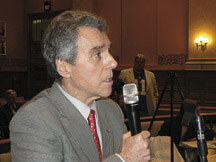Steve Hyman, the owner of the Sixth Street Embankment property – a former railroad property that some activists want preserve as a public park – spoke out recently at two public meetings last week about his desire to develop homes there.
Hyman shared his struggles at the April 22 City Council meeting and at a special meeting of the Jersey City Historic Preservation Commission (HPC) on Wednesday. He complained to both bodies about constantly having to battle city officials and the Pennsylvania Railroad Harsimus Stem Embankment Preservation Coalition for the right to develop the land, which is historically landmarked by the city and is on the state’s Register of Historic Places.
He noted that he has made large compromises to leave much of the land as open space.
The Embankment is a series of sandstone and granite blocks spanning Sixth Street downtown, from Marin Boulevard to Brunswick Street, over which a section of a Pennsylvania Railroad freight line ran from 1902 until the late 1970s. Hyman bought the property in 2005 from Conrail for $3 million.
At first, he wanted to demolish the embankment and build two-family homes. After protests from community activists, he has come up with various plans to leave large amounts of the 5.6-acre, six-block structure as open space, so he can get the go-ahead to develop the rest.
But the city has not approved any of his plans.
“Jersey City has been stopping me at every turn, taking me to federal court … taking me to the nuthouse by not letting me do what I am entitled to do,” Hyman said at the HPC meeting.
The commission was to hear applications from Hyman for “certificates of economic hardship.” If he got the certificates, he could demolish the Embankment structure. But he has to prove he can get a better profit return from the property if he does so.
The commission will hear more testimony on the certificates at a meeting scheduled for Monday at City Hall, 280 Grove St. at 6:30 p.m.
Is there really economic hardship?
At Wednesday’s meeting, lawyers for Hyman and his various consultants and planners presented new plans for multi-family townhouses, a total of 32 units. These homes would be placed on top of four of the six blocks and would preserve 98 percent of the Embankment walls, which Hyman attorney Michelle Donato called a “minimally intrusive” alternative.
At the same time, Hyman’s representatives offered an alternate argument in favor of demolition, saying the town house plan would require over $40 million to stabilize the walls and another $15 million in “extraordinary costs” such as preliminary work before construction.
Hyman’s consultants also presented of renderings of million dollar mansion-type homes, 12 of which Hyman has suggested he would consider building on top of the Embankment if he can’t demolish it.
Several of the commissioners as well as Jack Dineen, an outside attorney retained by the city to sit in on the Embankment hearings, questioned Hyman’s representatives about the costs he presented. Commissioners Heather Martin and Scott Mittman wanted to see documentation by the next meeting giving a cost breakdown.
“I don’t know, it just seems so unlikely.” – Heidi Bolivar
________
Jennifer Meyer, former president of the Embankment Coalition, said outside the meeting that Hyman should stick with his earlier plan to build on the eastern end of the Embankment overlooking Marin Blvd. and on land west of the embankment, on Brunswick Street and Newark Avenue. That plan calls for 600 units to be built, and Hyman would donate the other five blocks to the city for park land and a light rail line.
Heidi Bolivar, who lives on Sixth Street, couldn’t understand how Hyman’s plan would work.
“I don’t know, it just seems so unlikely,” Bolivar said. “I still think the walls should stay intact.”
The coalition also pointed out that there are still legal questions about whether the railroad’s sale of the property to Hyman in 2005 was done according to the rules of the Surface Transportation and Safety Board (STB), which say that a railroad must offer its property for public use before “abandonment” and selling it to a private owner.
The STB’s rules would theoretically void the land sale to Hyman, but Conrail is still fighting a decision the STB rendered against them by filing exemptions with the STB to avoid the abandonment process.
Ricardo Kaulessar can be reached at rkaulessar@hudsonrreporter.com.
